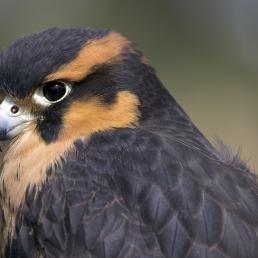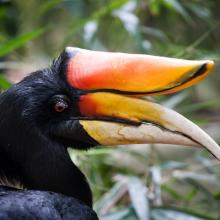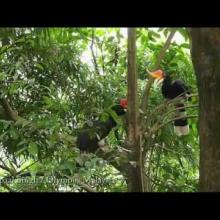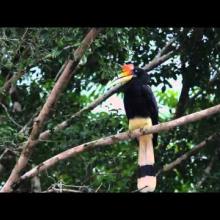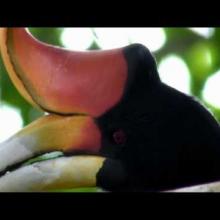

Join BirdNote tomorrow, November 30th!
Illustrator David Sibley and actor H. Jon Benjamin will face off in the bird illustration battle of the century during BirdNote's Year-end Celebration and Auction!
Rhinoceros Hornbills are among the largest of the world’s 54 species of hornbills, which are spread across Africa and India to Asia and New Guinea. Some hornbills eat mostly fruit. Others are carnivorous, snapping up lizards, small mammals, and birds. Most live in mature, tropical forests, but some are desert dwellers. And a few species spend nearly all their lives on the ground, even though they are strong fliers. When a hornbill does fly, the powerful strokes produce a rhythmic thrumming. Not a helicopter – but a hornbill.
BirdNote®
Rhinoceros Hornbill
Written by Bob Sundstrom
This is BirdNote.
[Rhinoceros Hornbill wing sounds in flight: http://www.xeno-canto.org/284705]
A brisk, rhythmic thrumming carries through the forest in Borneo. What sounds like an approaching helicopter are actually the wing-beats of a remarkable bird called the Rhinoceros Hornbill.
[Rhinoceros Hornbill wing sounds in flight: http://www.xeno-canto.org/94118]
It’s hard to talk about a Rhinoceros Hornbill without resorting to superlatives. [Rhinoceros Hornbill call, http://macaulaylibrary.org/audio/6675, 0.05-.07] For one thing, it’s nearly four feet long yet flies nimbly among the trees. Feathered mostly in black, it has an outlandish, down-curved, yellow beak shaped like that of a toucan.
But its most striking feature sits on top of its head: a bright red, horn-shaped structure that looks like an extra beak, but turned upside down. This extra crown-piece – called a casque – curves upward and its size, shape, and color mark the bird’s age and sex, and affected status! [Rhinoceros Hornbill call, http://macaulaylibrary.org/audio/6675, 0.05-.07]
Rhinoceros Hornbills are among the largest of the world’s 54 species of hornbills, which are spread across Africa and India to Asia and New Guinea. Most live in mature tropical forests, but some are desert dwellers. And a few species spend nearly all their lives on the ground, even though they are strong fliers.
And when a hornbill does fly, the powerful strokes produce that rhythmic thrumming. [Rhinoceros Hornbill wing sounds in flight: http://www.xeno-canto.org/284705] Not a helicopter – but a hornbill.
For BirdNote, I’m Michael Stein.
###
Bird sounds provided by The Macaulay Library of Natural Sounds at the Cornell Lab of Ornithology, Ithaca, New York. 6675 recorded by Andrea L Priori.
XC 284705 recorded by Bas van Balen, 94118 recorded by Eric Cannizaro. www.xeno-canto.org
BirdNote’s theme music was composed and played by Nancy Rumbel and John Kessler.
Producer: John Kessler
Executive Producer: Sallie Bodie
© 2017 Tune In to Nature.org January 2017/2019/2021 Narrator: Michael Stein
ID# hornbill-01-2017-01-12 hornbill-01
